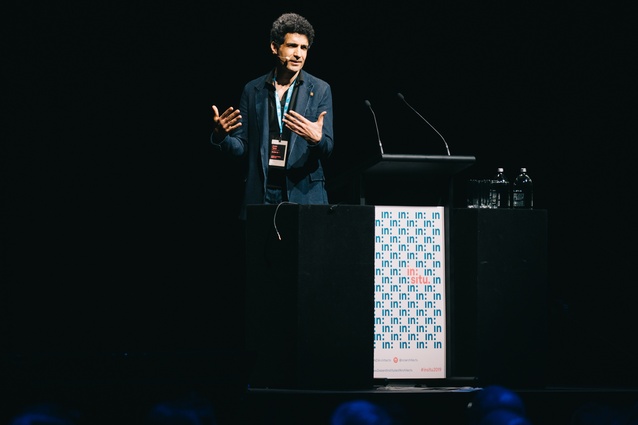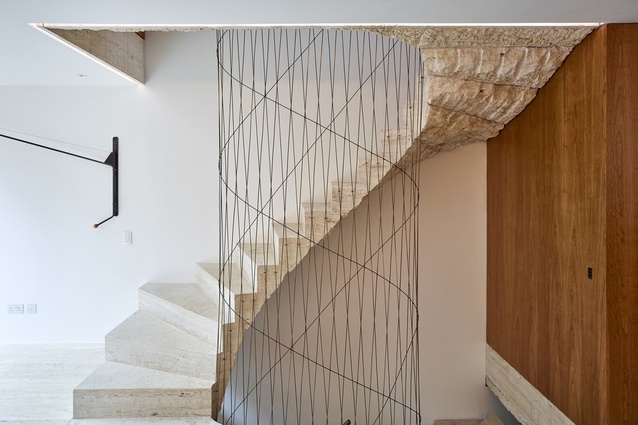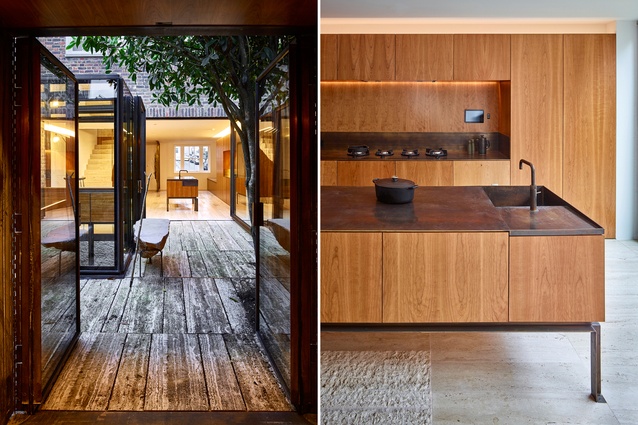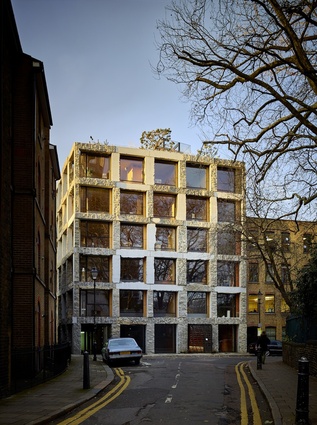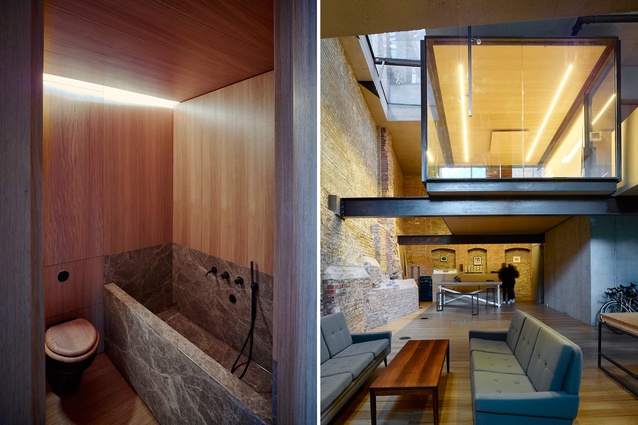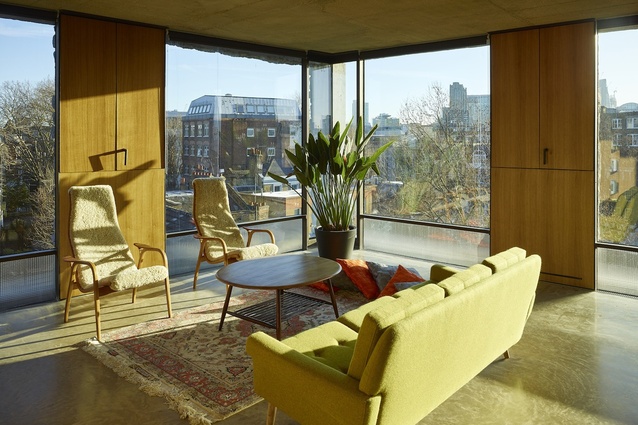In:situ 2019 series #1: Amin Taha
In the first of our series of interviews at the New Zealand Institute of Architects 2019 in:situ conference, Julia Gessler spoke to London-based architect Amin Taha before his keynote speech to further understand his methodology and practice and the lessons he's communicating during his time in the antipodes.
Julia Gessler (JG): Recent projects of yours with your firm Groupwork, from Caroline Place to Clerkenwell Close, have used tactile materials and finishes to varying degrees and to surprising effects. Can you tell us about the significance that materials play in your work?
Amin Taha (AT): Materials are what you make architecture out of. Instead of architecture just being a two dimensional drawing that represents a form that you might colour in, render in watercolour or in CAD software and then decide how that is going to be built, you might decide from the very beginning that if architecture is actually made of all of these materials, the spectrum of materials is endlessly at your availability.
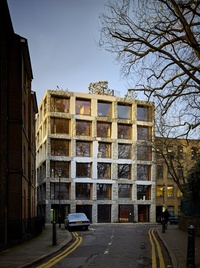
If you decide beforehand what it’s going to be made of, the materials are the vocabulary for whatever it is you want to tell in your architecture. It therefore makes the materials fairly intrinsic. Just by virtue of deciding from a very early stage that you’re going to use these things to not only hold up the building but also tell a story about the architecture, they become the tactile experience of the final product.
JG: I’m interested in your rejection of style. How necessary do you think boundary-bending or -breaking is to an approach to a project, and architecture more generally?
AT: In the talk I’ll give, I will touch on the issue of style, and that really comes about mostly because people such as yourselves – journalists, opinion-makers, historians – are often educated in the classical art history manner, and there’s a very good reason for that; to all education there’s a taxonomy and a description – a categorisation of information. The disadvantage of that system is that you will approach the identification of anything new with a temptation to put it into a predetermined category: into that taxonomy, as it were.
So where previously, prior to formal art history (that would have been prior to the mid 18th century), style or design or art would have been categorised by the particular individual who was innovating in a particular way, maybe in pigments or plastic, in sculpture or in metalwork. It’s really the biography of the person who is innovating in that material to create that product. Prior to categorisation and the definition of styles was where style came out of the process.
We can mention plenty of architects whose body of work over the last 10 years was defined by much of a particular in-house style. I will turn and pose that question back to the person who is asking about style – the journalist, the art historian, the critic – and ask them to question whether style should really be defined by the typical taxonomy of categorisation, or whether it should be a better understanding of the processes that actually produce the product?
JG: Do you have a specific method you apply to projects?
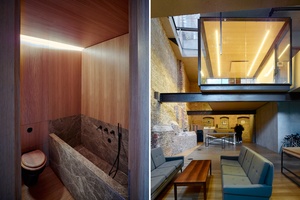
AT: Explore, ignore, restore. That means you might spend the first few weeks or months of a project actually just exploring the entire project as a whole. That means not just the brief the client has given you – its budget and its expectations and the outcomes – but also the context in which the site sits that they’ve given you. That context is not just physical typography and how the sun moves across the site or different weather conditions across the year. But, actually, if you slice through the historical context – the anthropological layers – you’ll get potentially informed enough that you might be able to influence the design, some stronger than others.
That’s an explore period before you actually draw anything, because you might be tempted to just literally draw something that’s come from a previous project that came to your mind. And, that is the result when architects will reproduce one project after another that has the house style and is easily recognisable and categorizable, because why should one context be different from another? Why should it influence the design? If you don’t want to explore for a period, it won’t. If you allow a period of no influence on the design at all, apart from what you discover at that particular location, that’s where the metaphysical might begin to influence the design.
JG: What can other architects learn from this methodology?
AT: I would hate to say that we are some sort of innovators of this methodology because I would rather say that all we’re doing is actually what people did several hundred, if not thousands, of years ago, which is to master materials – master the craft – and express your skills accordingly. That might be very idiosyncratic to your practice, to yourself, compared to the person next to you, but I think that’s actually an advantage. Ultimately, different architects working on the same project, working on the same site, doing the same exploration, may have a different poetic result than yourself.
JG: How do you think your office – and subsequently your projects – benefit from your current business model: an employee-owned business that largely sees the dissolution of an internal hierarchy?
AT: Inevitably, there’s always a hierarchy. We try our best not to have a hierarchy. The immediate advantages of becoming an employee-ownership trust is it dissolves that hierarchy legally, formally and informally, because suddenly you don’t have equity partners who own the practice and therefore are acting in their own interests. The others have no financial interest, no potential retirement plans or pension plans in it; they feel that even if their futures or financial trusts are being influenced by those in the practice, they don’t have an influence over their own directions. By becoming an employee-ownership trust, it gives them the advantage of having a say, directing the practice towards their own interests.

In terms of design, it’s probably pretty much as we’ve always done it, which from the outside was fairly democratic in that a group of us would be working on different projects, then we put them up for review to the entire office on a regular basis. The idea is that we’re hopefully all mature enough not to be upset when someone explains to you why something might not work. You take that on board and run with it.
JG: Do you think this business model can be applied to a comparatively larger firm?
AT: Yes, I think so.
JG: What are you hoping to communicate to New Zealand audiences in your time here?
AT: There are important lessons in housing provision – that’s affordable, low-cost methods of housing provision. That inevitably means their capital costs are low and therefore rentals are lower, if that’s the model of affordable housing.
Then there are lessons in bringing down construction costs and making construction much more sustainable. Whether it’s bringing down the carbon footprint of a building by 90 per cent because you’re careful about the materials you choose and then the ongoing maintenance and running costs of those buildings, or how to create a model for actually providing a lot more housing that people can afford to live in, which we only learnt quite recently when having to tackle massive projects.
You realise there’s an epiphany moment when you think that the private sector will ultimately never produce affordable housing because it’s not in their DNA, so it’s up to the public sector. If you leave it to contractors and to the standard ways of doing things, it’ll never change. You have to show clients why it’s in their best interests to choose a certain method of construction that is far cheaper for them and, at the same time, is far more sustainable.
They’re not being taxed for being unsustainable. They’re more interested in getting the construction costs low so they can make a sustainable profit. If you can show them that doing the latter – getting a good profit – has a byproduct of also reducing your carbon footprint by 90 per cent, why not do that?

JG: That is important given New Zealand’s housing market.
AT: Yes. If you go to most of the world since the 1980s – that is, since the privatisation model came into effect in most countries – it seemed to make a great deal of sense at that time. What people hadn’t quite foreseen, or that people had foreseen and weren’t listened to, was that ultimately the DNA of the private sector is to make profit.
If you’re being asked to provide another half a million houses because there’s a shortage, you won’t do it. If you did do it – let’s say you had the labour force at hand to actually produce that within a short space of time – that volume of housing provided into the private sector market would crash the market and wipe out the private housing sector. In your DNA is always a want to sustain an underprovision – a just-underprovision – that maintains a high enough value in what you are producing to make sure that you’re always in profit and you don’t go bust.
That’s what you do when you hand over the entire housing provision to the private sector – it’s in their interests; they don’t conspire, they don’t sit in smoky rooms wringing their hands to make an under provision – it’s just structural in whatever you’re making, whether that’s cups and saucers or houses or washing machines. You will provide enough for the market to ensure that the price that you’re selling at still makes you a profit. If you over-provide, the price crashes or you’re not making a profit until the excess is absorbed.
The only way of balancing that, or rebalancing that, is that first of all, politically, you have to persuade the public that living in public sector housing – what in the UK we call council housing – is not a shame. Since the 1980s, people were able to buy the council houses they were renting at the time. You were able to buy – and still are able to buy – it at quite a dramatic discount compared to the equivalent of a flat or house in the private sector, on the condition that you didn’t sell for five years or so.
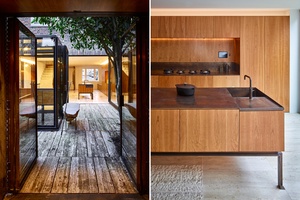
If you did sell, most of the profits would go back to the council. If after five years or so you did sell, then you could keep all of it. What people realised was that they could buy a discounted home, hold onto it, sell it for a huge profit, and then go and move out to the suburbs and keep that profit. What that did was take out a whole quantum of public council housing rented at affordable rates, and then handed it over to the private sector.
The second thing you need to do is to look at all that land that’s owned by the government – owned by you and me as taxpayers – and say, “Right, we can actually build on this stuff in the centre of town. Let’s build a block of flats. We own it for nothing”. The value of it is what we build on it. So if we build 20 flats on it, that’s the value of it.
The private sector would look at that and say, “Right, this land has got the potential for millions on it. I will sell that for millions and let somebody else build on it and they make their profit after the construction”. If you’ve owned the land as a local authority, you’re not buying it; you’ve effectively got the land for free. All you’ve got to do now is invest in the construction of something. If you do that, what you’ve done is you’ve reduced your debt on that land by a third. This effectively means you’re creating housing that, compared to the private sector, can be cheaper to construct and, inevitably, cheaper to rent.
JG: How long do you think it will take to strike this rebalance?
AT: A lot of us depend on the private sector. How that balance is struck is the challenge politicians are having. The private sector has to be aware something like that is going to happen. They therefore balance how much they are going to produce compared to what’s being produced by the public sector. As long as you’re not oversupplying where the private sector is no longer making a profit, you’ll hit a balance that’s sustainable – a sustainable balance forever. How long that balance will take, I don’t know. We’ve never had a period where we’ve hit perfect provision.
The 2019 in:situ conference was presented by the New Zealand Institute of Architects. The primary sponsor for this event was GIB.

